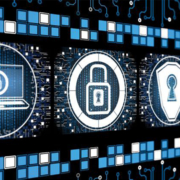How Has Cybersecurity Evolved in 2023?
How has cybersecurity evolved? What are the future trends in the industry?
The game of cat and mouse “played” by defenders and attackers will continue to drive the evolution of cybersecurity. The game is ongoing, with each side adopting and adapting the strategies and tactics of the other.
In this article, we will explore how cybersecurity has evolved and what we expect to see in the coming years.
How Has Cybersecurity Evolved?
In thinking about how cybersecurity has evolved, a few key trends come to mind
Evolving Cybersecurity Trends |
|
| Artificial Intelligence and Machine Learning | Security systems powered by AI/ML detect and respond to threats in real time, while cybercriminals use these technologies to launch more sophisticated attacks. |
| Post-Quantum Encryption | Integrating quantum-resistant encryption will be crucial to maintaining secure communications in a post-quantum computing era. |
| Zero Trust Architecture | Perimeter-based security approaches are giving way to a Zero Trust model, where no user or device is inherently trusted. |
| Blockchain | Blockchain, which forms the basis of cryptocurrency, will be used to enhance data integrity and potentially increase the security of transactions. |
| Internet of Things Security | The scale and diversity of IoT devices and Industrial Control Systems (ICS) will pose ongoing challenges for security professionals. |
| Cloud Security | Cloud providers continuously enhance their security offerings, such as data encryption, access control, and threat detection. Conversely, hackers target cloud installations because they are a central repository of the crown jewels in any organization. |
| Human-Centered Cybersecurity | The future of human-centered cybersecurity will be shaped by technology and an increasing understanding of the role of individuals in securing digital systems. |
Artificial Intelligence and Machine Learning
Artificial intelligence and machine learning (AI/ML) technologies, such as ChatGPT, are playing an increasing role in our lives. While AI/ML-powered security systems can detect and respond to threats in real time, cybercriminals also use these technologies to launch more sophisticated attacks. We expect to see defensive and offensive advancements in AI/ML, with uncertainty about which side will prevail.
Post-Quantum Cryptography
The quantum computing revolution poses a threat to data encryption. Post-quantum encryption algorithms are being developed so encryption can withstand quantum computer attacks. In the post-quantum era, we’ll need quantum-resistant encryption to keep communications secure.
Internet of Things Security
Internet of Things (IoT) devices are proliferating, so securing them has become increasingly important. Connected devices present new attack surfaces and vulnerabilities. IoT security frameworks and standards are being developed, but the scale and diversity of IT devices pose ongoing challenges for companies and security professionals.
Zero Trust Architecture
Perimeter-based security is giving way to Zero Trust, where no user or device can be trusted. In Zero Trust, identity verification is strict, monitoring is continuous, and the least privilege access applies. With this approach, you’re more protected from insider threats and external attacks.
Blockchain Technology
Blockchain technology, which underpins cryptocurrency, is being explored for security applications. Blockchain can boost data integrity, make transactions more secure, and manage identities better. It holds potential for supply chain security, identity verification, and decentralized authentication.
Cloud Security
Security of cloud-based systems and data is becoming critical as more organizations adopt cloud computing. Cloud providers keep improving their security features, like encryption, access controls, and threat detection. There is likely to be an even greater advancement in cloud security solutions and practices in the future.
Human-Centered Cybersecurity
There’s a growing focus on educating people about cybersecurity and promoting security awareness. The future of human-centered cybersecurity will be shaped by technology and a better understanding of the role of individuals in securing digital systems.
The Future of Human-Centered Security
Let’s think more about human-centered cybersecurity for a moment. Several factors will shape how human-centered cybersecurity evolves, including:
- User-Centric Design: Cybersecurity solutions will be designed with user experience and usability in mind. This means making user interfaces intuitive, simplifying complex security processes, and providing clear instructions. The goal is to minimize user errors and make security measures more accessible to everyone.
- Behavioral Biometrics: Passwords and PINs are traditional methods of authentication that can be compromised. But in the future, there will be a shift towards using behavioral biometrics, like keystroke dynamics, mouse movements, and gait patterns, to uniquely identify people. It’s harder for attackers to replicate these characteristics, so it’s more secure.
- Contextual Awareness: As cybersecurity systems become more contextually aware, they adapt their behavior to the user’s environment, location, and device characteristics. Contextual awareness can help systems adjust security measures, like prompting users for additional authentication when accessing sensitive data from an unfamiliar location or device.
- Continuous Education: Future cybersecurity approaches will focus on continuous user education and awareness. Organizations will invest in education and security awareness training to ensure their employees know about common threats, best practices, and how to spot and respond to potential attacks. By doing this, they’ll foster a culture of security consciousness and empower people to make informed digital decisions.
Remember that humans are only the weakest link in cybersecurity if you treat them that way. As cybersecurity evolves, educating employees will become more important than ever to ensure they become your greatest defense against cybercrime.
___________________________
John Sileo is an award-winning cybersecurity keynote speaker who educates audiences on how cybersecurity has evolved and how they can remains ahead of trends in cybercrime. He is proud to have spoken at the Pentagon and Amazon, written four books on cybersecurity, and been inducted into the National Speakers Hall of Fame. He has appeared on 60 Minutes, NBC, ABC, Fox, CNN, Rachael Ray, and Anderson Cooper. John’s work has been quoted and published in The Wall Street Journal, The Washington Post, USA Today, and Kiplinger’s.
Looking for a customized speech to make your next event unforgettable? Call 303.777.3221 or fill out our contact form to connect with Sue, our business manager extraordinaire. She’ll work with you to brainstorm ideas and explore how John can tailor his speech to fit your needs perfectly.






 sileo.com
sileo.com 




